Bus leakage resistance estimation for electrical isolation testing and diagnostics
Gale , et al. Sept
U.S. patent number 10,406,921 [Application Number 15/664,615] was granted by the patent office on 2019-09-10 for bus leakage resistance estimation for electrical isolation testing and diagnostics. This patent grant is currently assigned to FORD GLOBAL TECHNOLOGIES, LLC. The grantee listed for this patent is FORD GLOBAL TECHNOLOGIES, LLC. Invention is credited to Allan R. Gale, Richard W. Kautz.
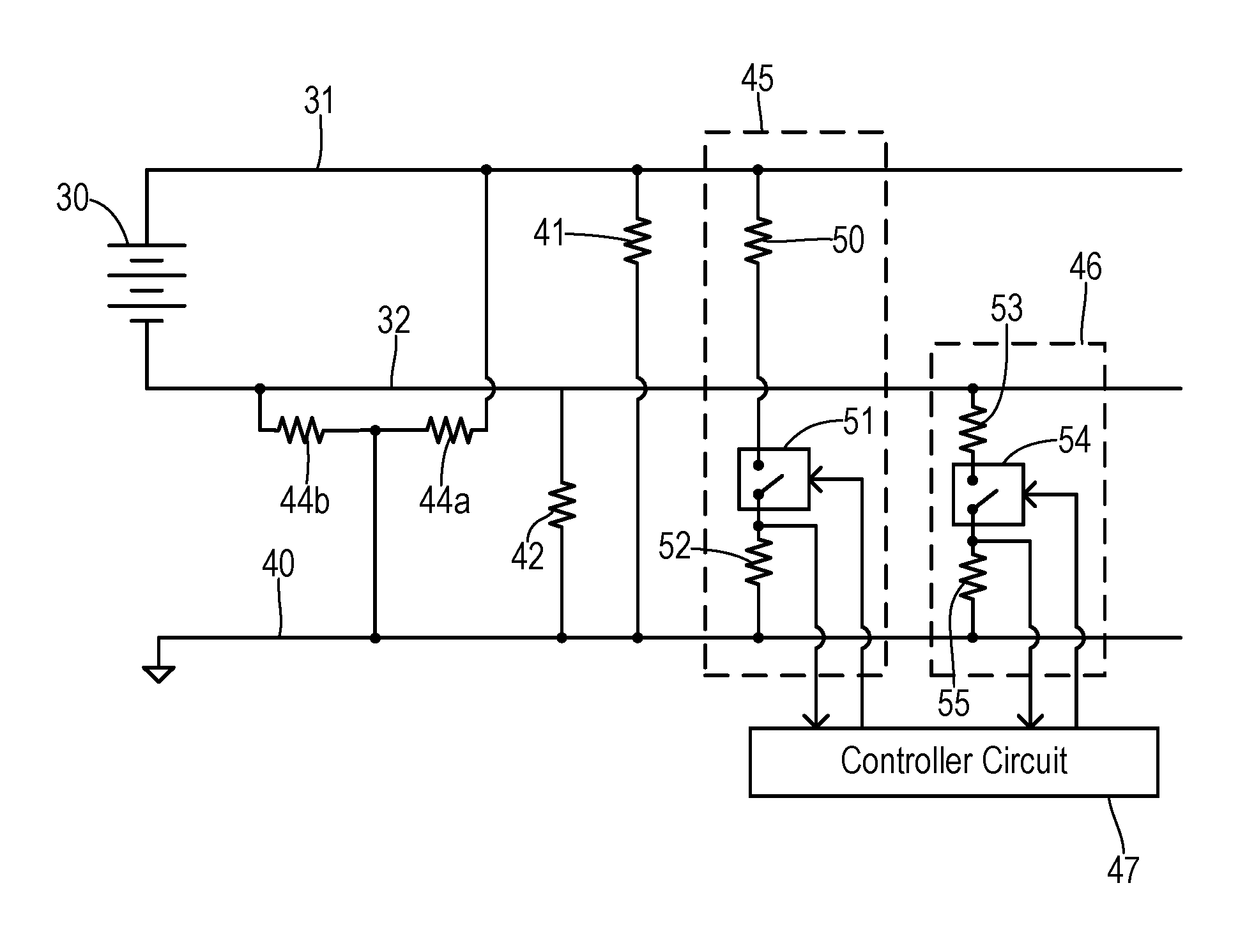
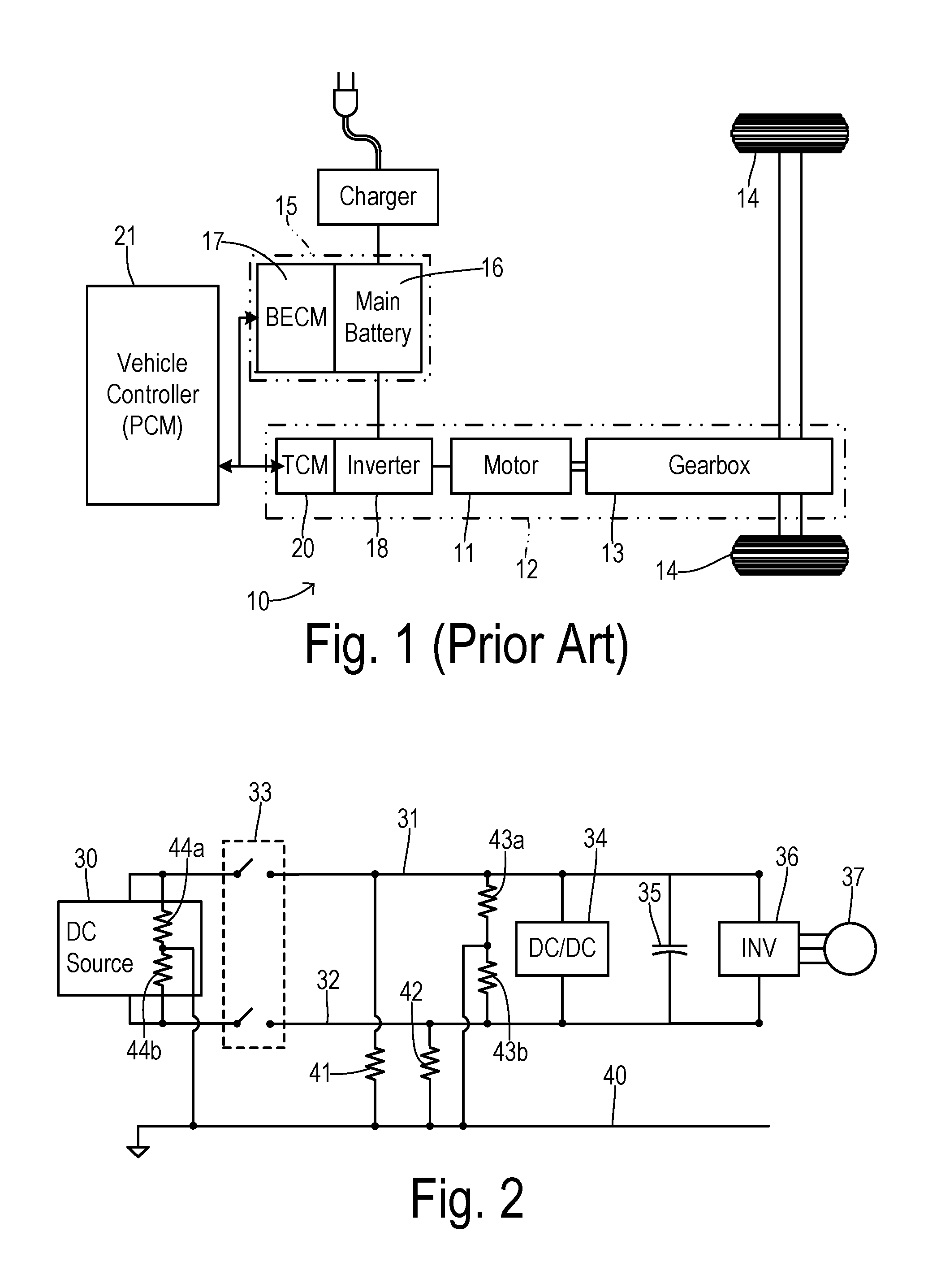
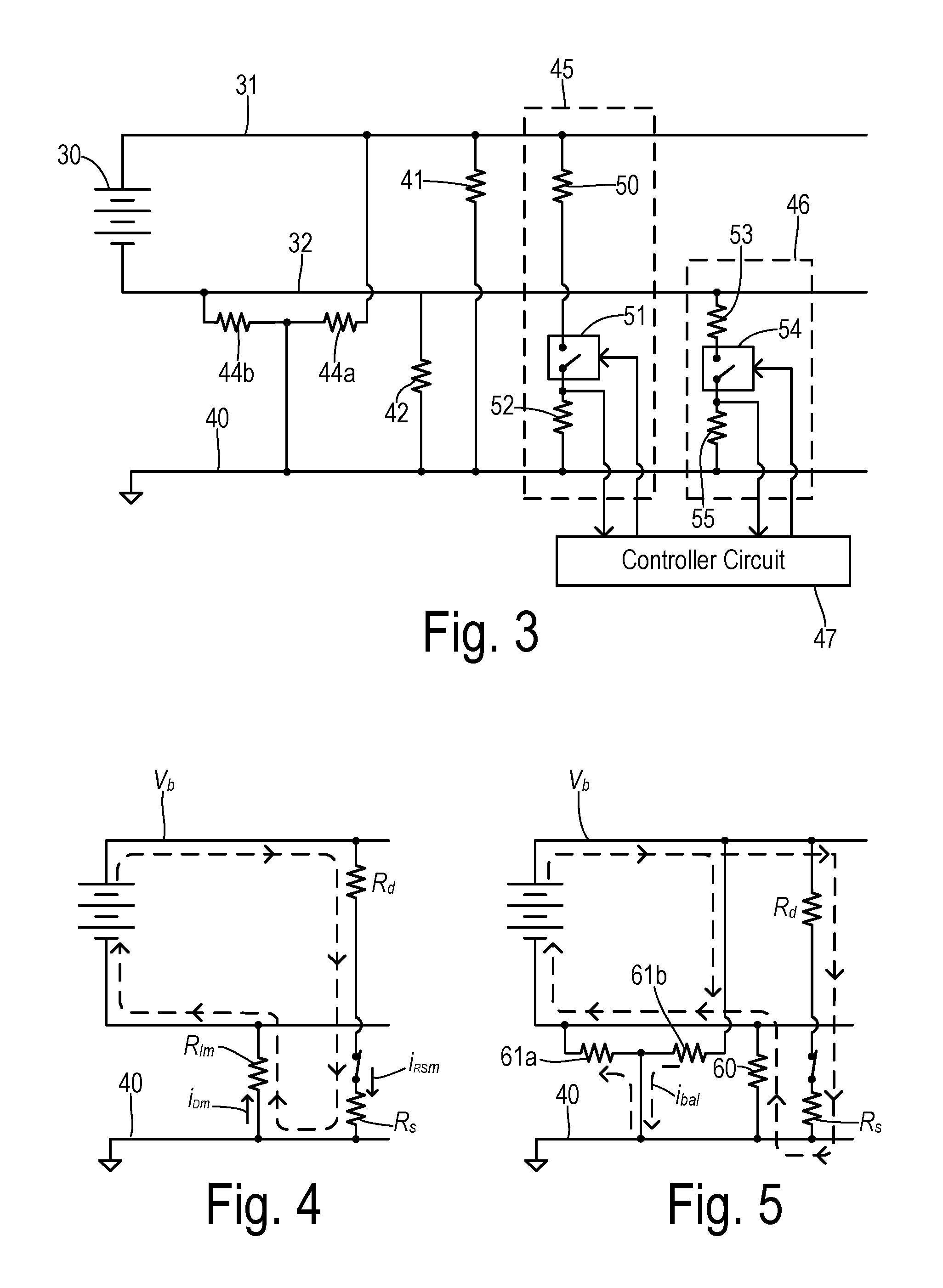
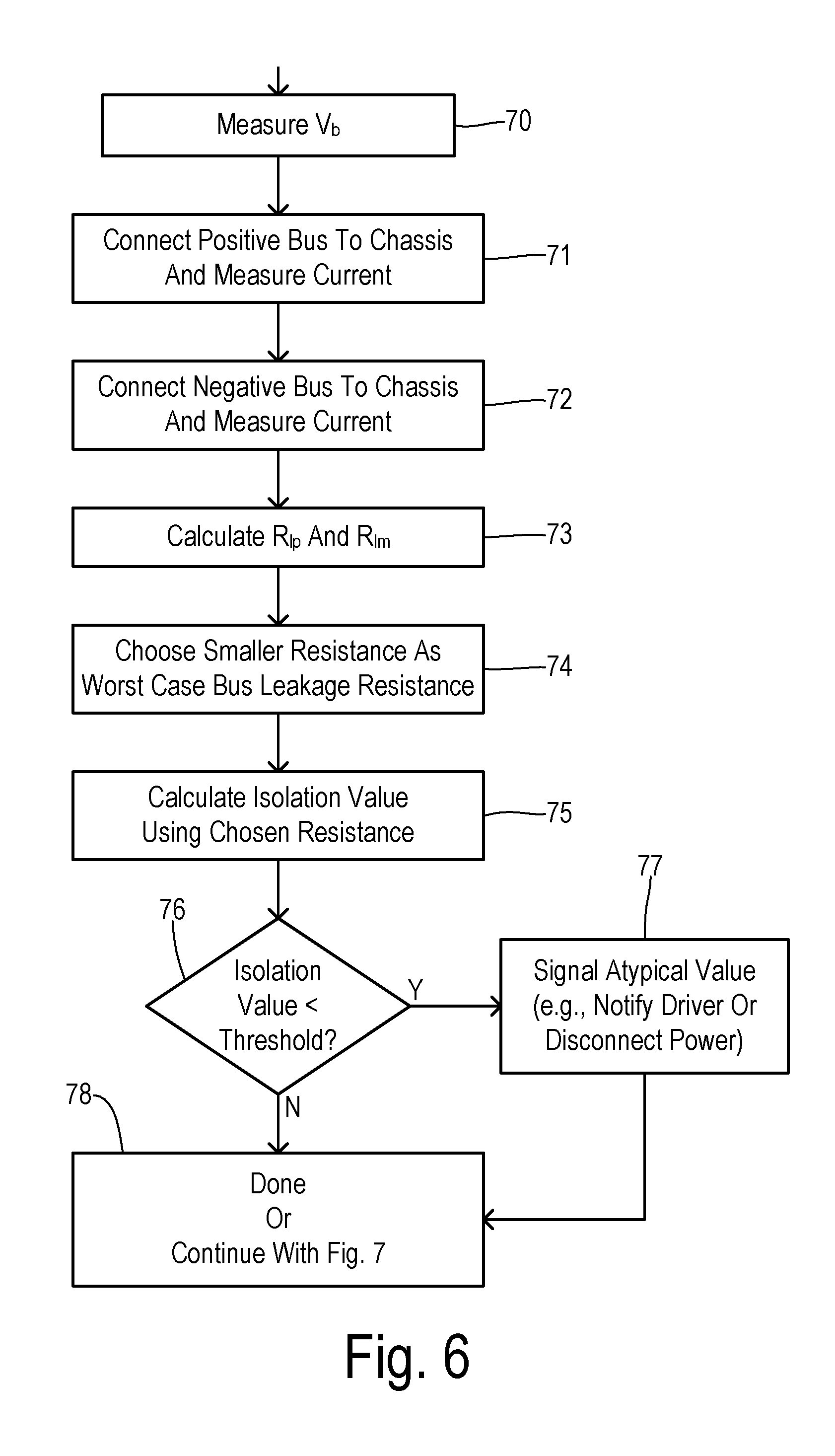
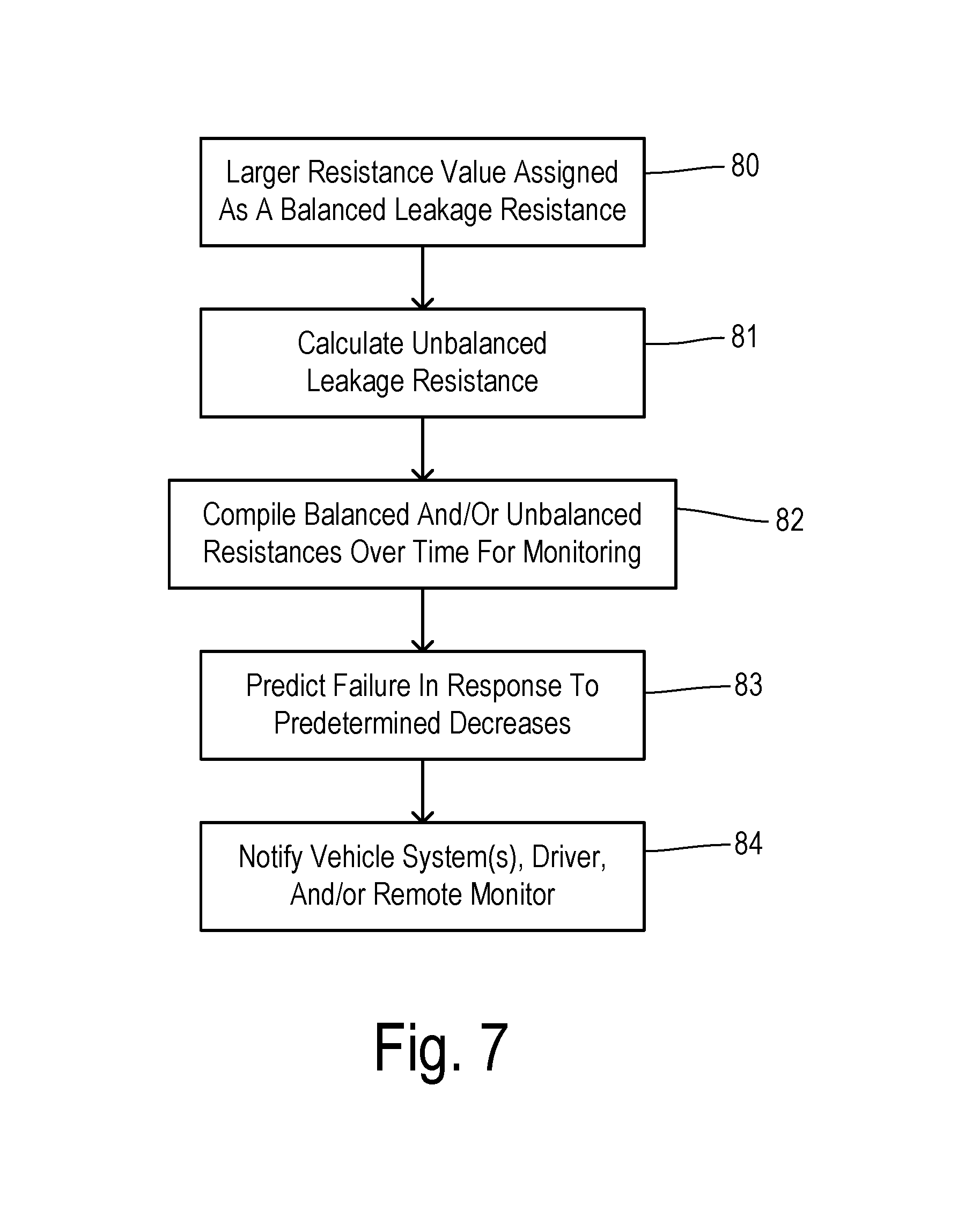







View All Diagrams
| United States Patent | 10,406,921 |
| Gale , et al. | September 10, 2019 |
Bus leakage resistance estimation for electrical isolation testing and diagnostics
Abstract
Electrical bus isolation is detected for an electrified vehicle having a DC power source connected to positive and negative buses. The positive bus is connected to chassis ground, and a resulting first current is sensed that flows through a negative bus leakage resistance and a balanced leakage resistance. The negative bus is connected to chassis ground, and a resulting second current is sensed that flows through a negative bus leakage resistance and a balanced leakage resistance. The positive and negative bus leakage resistances are estimated in response to respective ratios of the first and second currents. An isolation value is compared to a threshold, wherein the isolation value is responsive to a voltage of the DC power source and a smaller one of the positive and negative bus leakage resistances. An atypical isolation is signaled when the isolation value is less than the threshold.
| Inventors: | Gale; Allan R. (Livonia, MI), Kautz; Richard W. (Rochester, MI) | ||||||||||
|---|---|---|---|---|---|---|---|---|---|---|---|
| Applicant: |
|
||||||||||
| Assignee: | FORD GLOBAL TECHNOLOGIES, LLC
(Dearborn, MI) |
||||||||||
| Family ID: | 55531269 | ||||||||||
| Appl. No.: | 15/664,615 | ||||||||||
| Filed: | July 31, 2017 |
Prior Publication Data
| Document Identifier | Publication Date | |
|---|---|---|
| US 20170326986 A1 | Nov 16, 2017 | |
Related U.S. Patent Documents
| Application Number | Filing Date | Patent Number | Issue Date | ||
|---|---|---|---|---|---|
| 14504588 | Oct 2, 2014 | 9758044 | |||
| Current U.S. Class: | 1/1 |
| Current CPC Class: | B60L 3/0069 (20130101); G01R 27/025 (20130101); Y02T 10/72 (20130101); G01R 31/50 (20200101); G01R 31/52 (20200101); G01R 31/007 (20130101); Y02T 10/70 (20130101) |
| Current International Class: | B60L 3/00 (20190101); G01R 27/02 (20060101); G01R 31/00 (20060101); G01R 31/02 (20060101) |
References Cited [Referenced By]
U.S. Patent Documents
| 7626396 | December 2009 | Lindsey et al. |
| 7714587 | May 2010 | Lindsey et al. |
| 8207741 | June 2012 | Kang et al. |
| 8222907 | July 2012 | Streit |
| 2005/0231153 | October 2005 | Dewey et al. |
| 2009/0001993 | January 2009 | Lindsey |
| 2011/0049977 | March 2011 | Onnerud et al. |
| 2011/0304339 | December 2011 | Schumacher et al. |
| 2012/0221269 | August 2012 | Wanner et al. |
| 2013/0151175 | June 2013 | Streit |
| 2013/0245869 | September 2013 | Nishida et al. |
| 2014/0253139 | September 2014 | Lindsey et al. |
| 2015/0362543 | December 2015 | Gale et al. |
| 2694288 | Apr 2005 | CN | |||
| 2013214475 | Oct 2013 | JP | |||
| 2010029353 | Mar 2010 | WO | |||
Other References
|
Aravind Mathsyaraja, Ground Fault Detection for Flexible High Voltage Power Systems, a Thesis, Michigan State University, Master of Science, Electrical Engineering, 2010. cited by applicant. |
Primary Examiner: Nguyen; Vincent Q
Attorney, Agent or Firm: Kelley; David B. MacMillan, Sobanski & Todd, LLC
Parent Case Text
CROSS REFERENCE TO RELATED APPLICATIONS
This application is a divisional of co-pending U.S. application Ser. No. 14/504,588, filed Oct. 2, 2014, which is incorporated herein by reference.
Claims
What is claimed is:
1. A method of monitoring bus isolation using bus leakage resistances exhibited by first and second buses in an electrified vehicle, comprising: measuring first and second leakage-related currents for the first and second buses by sequentially connecting each bus to chassis ground via respective detector circuits each comprising a respective limiting resistance and a respective sense resistance selectably connected between the respective bus and the chassis ground; estimating each bus leakage resistance in response to 1) a bus voltage present during the measuring step divided by the respective first and second leakage-related currents and 2) respective ratios of the first and second currents; selecting a bus isolation value according to a smaller one of the estimated bus leakage resistances, including balanced and unbalanced leakage resistances; and estimating a balanced leakage resistance by selecting a larger one of the estimated bus leakage resistances.
2. The method of claim 1 further comprising the step of: estimating an unbalanced leakage resistance according to a formula: .times..times..times..times. ##EQU00007## where R.sub.lp and R.sub.lm are the estimated bus leakage resistances.
Description
STATEMENT REGARDING FEDERALLY SPONSORED RESEARCH
Not Applicable.
BACKGROUND OF THE INVENTION
The present invention relates in general to electrified vehicles using a high voltage bus, and, more specifically, to accurate estimation of the effective isolation resistance present between each high-power bus and a chassis ground.
Electrified vehicles such as for electric vehicles and hybrid electric vehicles typically utilize a high voltage power bus driven by a DC power source which may include storage and/or conversion devices such as a multi-cell battery pack or a fuel cell. The presence of high-voltage buses creates a need for monitoring of the electrical isolation of each bus with respect to the electrically conductive components of the vehicle chassis (ground).
Any leakage resistance present between a DC bus and chassis ground must be sufficiently large. In typical leakage resistance detection systems, there is an assumption that leakage resistance will be between one of the positive or negative DC buses and chassis ground. A typical leakage detector circuit operates by periodically connecting one bus at a time to chassis ground through a current-limiting resistance, and using the resulting current flow to calculate the leakage resistance between the opposite bus and ground. The battery voltage divided by the calculated leakage resistance characterizes the electrical isolation.
The invention is based, in part, on a determination that conventional leakage resistance detection systems based on supplying a current from one bus through a known resistance to the leakage resistance between the ground and the other bus may ignore a potential balanced component of leakage resistance from both buses to ground that can sometimes result in the mischaracterization of the electrical isolation because of a potential discrepancy in the derived leakage resistance values. More specifically, a resistance may exist between the positive bus and chassis ground as well as a resistance of equal value between the negative bus and chassis ground. These resistances, both being equal in value, are hereafter referred to as symmetrical or balanced leakage resistance. A resistance on one bus to chassis without a matching value on the other bus to chassis is hereafter referred to as non-symmetrical or unbalanced leakage resistance. The additional current flow through the balanced leakage resistance may cause the prior art detection system to overestimate the composite balanced and unbalanced resistance which exists between one bus and chassis ground. Estimating this latter composite resistance is desirable in order to more accurately determine the isolation.
One typical source of a balanced leakage resistance would be a hydrogen fuel cell vehicle, wherein a deionizer intended to remove ions from water being used as a coolant fails to maintain proper deionization. As ions build up, the conductance of the cooling water increases and the electrical isolation between both positive and negative fuel cell electrodes and ground is reduced. Another possible source of a balanced leakage resistance includes a symmetrical breakdown in cable insulation.
SUMMARY OF THE INVENTION
The invention recognizes the presence of both balanced and unbalanced leakage resistance that exist between the positive and negative power buses and chassis ground. By differentiating between the leakage resistances that are the same for the two buses versus leakage resistance that is not the same, the invention more accurately determines the electrical isolation. Moreover, by separately identifying the balanced and unbalanced leakage resistances, detection and/or prediction of electrical or other vehicle conditions are enabled.
In one aspect of the invention, an electrified vehicle comprises a positive bus connectable to a positive output of a DC power source and a negative bus connectable to a negative output of the DC power source. A chassis ground is distributed within the vehicle. A first detector circuit is selectably activated to i) connect a first fixed resistance between the positive bus and chassis ground and ii) sense a resulting first current. A second detector circuit is selectably activated to i) connect a second fixed resistance between the negative bus and chassis ground and ii) sense a resulting second current. A control circuit identifies the positive and negative bus leakage resistances in response to a nonlinear function (e.g., ratio) of both the first and second currents. In one preferred embodiment, the current ratios provide a correction factor that can be applied to conventionally derived resistance values.
BRIEF DESCRIPTION OF THE DRAWINGS
FIG. 1 is a block diagram showing one type of electrified vehicle to which the present invention is applied.
FIG. 2 is a schematic diagram showing one typical bus structure with leakage resistances shown.
FIG. 3 is a schematic diagram showing test measurement circuits for characterizing bus leakage resistance.
FIG. 4 is a schematic diagram showing an idealized current flow that is a basis of a prior art leakage resistance measurement.
FIG. 5 is a schematic diagram showing an actual current flow during a test measurement which provides a basis for characterizing leakage resistance in the present invention.
FIG. 6 is a flowchart of one embodiment of the invention wherein an electrical isolation is determined with an improved accuracy.
FIG. 7 is a flowchart of a further embodiment of the invention wherein balanced and/or unbalanced leakage resistance estimates provide improved vehicle diagnostics.
DETAILED DESCRIPTION OF PREFERRED EMBODIMENTS
The term "electrified vehicle" as used herein includes vehicles having an electric motor for vehicle propulsion, such as battery electric vehicles (BEV), hybrid electric vehicles (HEV), and plug-in hybrid electric vehicles (PHEV). A BEV includes an electric motor, wherein the energy source for the motor is a battery that is re-chargeable from an external electric grid. In a BEV, the battery or other DC source supplies energy for vehicle propulsion. A HEV includes an internal combustion engine and an electric motor, wherein the energy source for the engine is fuel and the energy source for the motor is a DC storage unit such as a battery. In a HEV, the engine is the main source of energy for vehicle propulsion with the battery providing supplemental energy for vehicle propulsion (e.g., the battery buffers fuel energy and recovers kinematic energy in electric form). A PHEV is like a HEV, but the PHEV may have a larger capacity battery that is rechargeable from the external electric grid. In a PHEV, the battery may be the main source of energy for vehicle propulsion until the battery depletes to a low energy level, at which time the PHEV operates like a HEV for vehicle propulsion.
By way of example, FIG. 1 depicts a vehicle 10 as a battery electric vehicle (BEV) propelled by an electric motor 11 without assistance from an internal combustion engine. Motor 11 receives electrical power and provides drive torque for vehicle propulsion. Motor 11 also functions as a generator for converting mechanical power into electrical power through regenerative braking. Motor 11 is part of a powertrain 12 in which a gearbox 13 couples motor 11 to driven wheels 14. Gearbox 13 adjusts the drive torque and speed of motor 11 by a predetermined gear ratio.
Vehicle 10 includes a battery system 15 including a main battery pack 16 and a battery energy controller module (BECM) 17. An output of battery pack 16 is connected to an inverter 18 which converts the direct current (DC) power supplied by the battery to alternating current (AC) power for operating motor 11 in accordance with commands from a traction control module (TCM) 20. TCM 20 monitors, among other things, the position, speed, and power consumption of motor 11 and provides output signals corresponding to this information to other vehicle systems including a main vehicle controller 21 (which may be a powertrain control module, or PCM, for example).
FIG. 2 shows a typical bus architecture wherein a DC power source 30 is selectively coupled to a positive bus 31 and a negative bus 32 via contactor switches 33. Buses 31 and 32 may be further coupled to a DC-to-DC converter 34, a link capacitor 35, and an inverter 36 which drives a traction motor 37. A chassis ground 40 represents conductive parts of the vehicle whose electrical potential is taken as a reference and which are conductively linked together.
Electrical isolation of buses 31 and 32 is determined by the electrical leakage resistance between each bus and chassis 40. A leakage resistance 41 represents the level of isolation between positive bus 31 and chassis 40. Leakage resistance 42 represents the isolation between negative bus 32 and chassis 40. Leakage resistances 41 and 42 are the unbalanced or nonsymmetrical leakage resistances. While resistances 41 or 42 may occur only one can be present for the unbalanced resistance. In addition, a balanced leakage resistance, 43a and 43b having the same resistance, may be present between buses 31 and 32 having a junction between them connected to chassis 20. In addition, a balanced resistance may be introduced across buses 31 and 32 within DC source 30, shown as leakage resistances 44a and 44b having their junction coupled to chassis 40.
FIG. 3 shows apparatus for detecting leakage resistance wherein a first detector circuit 45 is arranged between positive bus 31 and chassis ground 40 and a second detector circuit 46 is arranged between negative bus 32 and chassis ground 40. First detector circuit 45 includes a current-limiting resistor 50 in series with a sampling switch 51 and a current-sensing resistor 52. A controller circuit 47 is connected to switch 51 for selectively activating switch 51 so that a resulting first current flowing through detector circuit 45 creates a voltage across current-sensing resistor 52 proportional to the current passing through resistor 52 which is provided to controller circuit 47. Likewise, second detector circuit 46 includes a series connection of a current-limiting resistor 53, sampling switch 54, and current-sensing resistor 55 similarly connected to controller circuit 47. Controller circuit 47 may include a microcontroller such as in a battery energy controller module.
In the leakage resistance detecting system based on conventional assumptions shown in FIG. 4, a current flowing through a current limiting resistor R.sub.d and current sensing resistor R.sub.s passes through leakage resistance R.sub.lm, which denotes leakage resistance to the minus bus. Using a measured battery voltage V.sub.B, the first measured current I.sub.rsm, and known resistance values for R.sub.d and R.sub.s, leakage resistance R.sub.lm is determined using the following formula:
.times..times..times. ##EQU00001## As previously explained, however, the resulting value for the leakage resistance does not take into account the balanced resistance which instead creates the more complex equivalent circuit shown in FIG. 5. In this case, the sense current is not entirely due to the parallel negative bus leakage resistances R60 and R61a. In addition, a current flows through R61b from the positive bus, providing an opposing component of the balanced leakage current i.sub.bal. Hence, the total sensed current under-represents the negative bus leakage current.
As seen from FIGS. 3 and 5, the total current through R.sub.lm (the leakage resistance associated with negative bus 32) includes balanced part from resistance 61 and a sense current I.sub.RS (i.e., including balanced and unbalanced portions of resistances 44, 41, and 42 of FIG. 3). When the sampling switch is closed, the current I.sub.RS is
.times..times..times..times..function..times. ##EQU00002## where R.sub.lp is the leakage resistance 41 and balanced portion of 44 associated with positive bus 31 (FIG. 3), R.sub.lm is the leakage resistance 42 and balanced portion of 44 associated with negative bus 32 (FIG. 3), I.sub.RSM is the sense current I.sub.RS as shown in FIG. 4 when switch 51 (FIG. 3) is closed, and resistance R.sub.C is a combined resistance (e.g., a fixed 519 k-ohms) which includes the sum of the current-limiting resistance R.sub.D and the current-sensing resistance R.sub.S. While the following text assumes the values of R.sub.D and R.sub.S in detector circuits 45 and 46 are equal to each other, for those familiar with the art these values may be changed while retaining the intent of this description. Thus, when the other sampling switch is closed, the current I.sub.dp can be determined using the formula:
.times..times..times..times..times..times..function..times..times..times. ##EQU00003## Equations 2 and 3 are solved simultaneously for leakage resistances R.sub.lp and R.sub.lm as follows:
.times..times..function..times..function..times. ##EQU00004## Thus, the ratios of the two measured currents provides respective correction factors to the conventional determination of the respective leakage resistances. The resulting values for the positive and negative leakage resistances, R.sub.lp and R.sub.lm, based on the current ratios provide a more accurate assessment of the leakage resistances, which consequently enables more accurate determination of a corresponding electrical isolation.
In a preferred embodiment, a bus having a lower isolation is used to calculate an isolation value. Thus, the smaller of the calculated leakage resistances is selected and then divided by a predetermined voltage in order to calculate the isolation value. The predetermined voltage can be comprised of the measured voltage (V.sub.B) of the DC source or a predetermined constant voltage (e.g., the nominal system voltage or a value specified by regulations). The isolation value can be calculated as follows:
.function..times..times..times. ##EQU00005## The resulting isolation value is compared with an isolation threshold (e.g., 500 ohms/volt), and if it is less than the threshold then the invention signals that an atypical condition has been detected. The signaling may be comprised of informing a driver of the condition and/or automatically disconnecting the DC power source from the power buses (e.g., opening the contactor switches).
The calculated values for leakage resistances R.sub.lp and R.sub.lm can further be used to separate the balanced and unbalanced components of the resistances so that the components can be monitored over time in order to detect or predict certain potential failures in the electrical system. Examples of balanced leakage resistances that can change over time in a manner that identifies an impending fault include a) insulation breakdowns, and b) loss of effectiveness of a cooling-water deionizer in a fuel cell system. A plurality of leakage resistance measurements over time can be separated into balanced/unbalanced components and stored in a database. Both the magnitude and slope within the stored data (e.g., either the balanced or unbalanced components) is used to predict potential failures. Examples of unbalanced leakage resistances that may change over time include contact of battery terminals to chassis, wire contact to the chassis, and other forms of contact.
The calculated values for leakage resistances R.sub.lp and R.sub.lm can be separated as follows. The larger one of leakage resistances R.sub.lp and R.sub.lm will correspond to the balanced resistance, i.e., R.sub.bal=max(R.sub.lp, R.sub.lm). This is because, by definition, the value of R.sub.bal must be the same from chassis ground to both the positive and negative buses. An unbalance resistance exists in parallel with the value of R.sub.bal, from either the positive or negative bus to ground. Since parallel resistances always result in a total resistance lower that each of the parallel resistances, the maximum of R.sub.lp and R.sub.lm corresponds to the balanced resistance.
The unbalanced resistance component can be calculated using R.sub.lp and R.sub.m as follows:
.times..times..times..times..times. ##EQU00006##
A method of the invention will be summarized in connection with the flowcharts of FIGS. 6 and 7. In step 70, the voltage V.sub.B of the DC power source is measured. In step 71, the positive bus is connected to the chassis ground and a resulting current is measured. The negative bus is then sequentially connected to chassis ground and a resulting current is measured in step 72. In step 73, leakage resistances R.sub.LP and R.sub.LM are calculated. The smaller of the two resistances is chosen in step 74 in order to identify a worst-case bus leakage resistance. In step 75, an isolation value is calculated using the chosen worst-case resistance.
In step 76, the isolation value is compared to an isolation threshold. If less than the threshold, then the invention signals an atypical condition in step 77 (e.g., by notifying the driver or disconnecting power to the high-voltage buses). If the isolation value is not less than the threshold, then the method is completed at step 78. Optionally, an additional method can be executed wherein the balanced and unbalanced resistance values are determined in order to provide prediction of potential failures as shown in FIG. 7.
In FIG. 7, the larger resistance value is assigned as the balanced leakage resistance in step 80. In step 81, an unbalanced leakage resistance is calculated (e.g., using Equation 7). The calculated values for the balanced and/or unbalanced resistances are compiled over time in step 82. In step 83, predetermined potential failures can be predicted in response to predetermined decreases in the balanced or unbalanced resistances. More particularly, a potential failure can be predicted in response to a magnitude of a resistance value falling below a threshold or in response to data points accumulated over time exhibiting a negative slope that points toward an impending drop in the resistance value below a threshold. For example, a predetermined decrease in the balanced resistance component may correspond to a certain loss in effectiveness in deionizing the coolant water for a fuel-cell (leading to decreased power generation). Empirical testing may identify the magnitude or slope values of interest that can be used to detected a need for corrective action to repair or replace the deionizer. Whenever a potential failure is detected or predicted, step 84 is executed to provide notification to other vehicle systems (e.g., a controller for deactivating the main contactors between the DC source and the buses), the driver (e.g., via a malfunction indicator light), or a remote monitoring system (e.g., wirelessly to a manufacturer's database via an electronic cloud).
* * * * *
D00000

D00001

D00002

D00003

D00004

M00001

M00002

M00003

M00004

M00005

M00006

M00007

XML
uspto.report is an independent third-party trademark research tool that is not affiliated, endorsed, or sponsored by the United States Patent and Trademark Office (USPTO) or any other governmental organization. The information provided by uspto.report is based on publicly available data at the time of writing and is intended for informational purposes only.
While we strive to provide accurate and up-to-date information, we do not guarantee the accuracy, completeness, reliability, or suitability of the information displayed on this site. The use of this site is at your own risk. Any reliance you place on such information is therefore strictly at your own risk.
All official trademark data, including owner information, should be verified by visiting the official USPTO website at www.uspto.gov. This site is not intended to replace professional legal advice and should not be used as a substitute for consulting with a legal professional who is knowledgeable about trademark law.